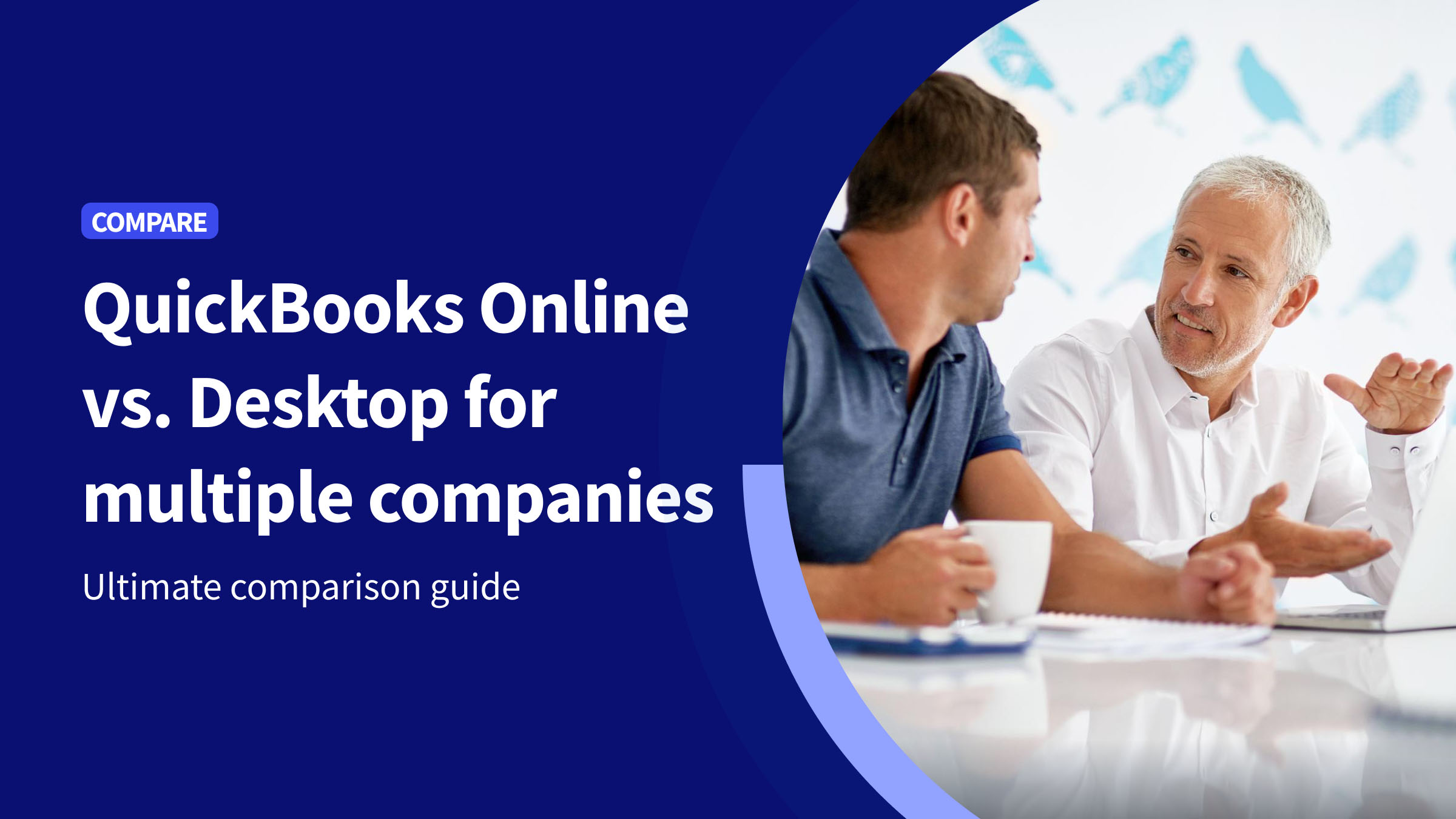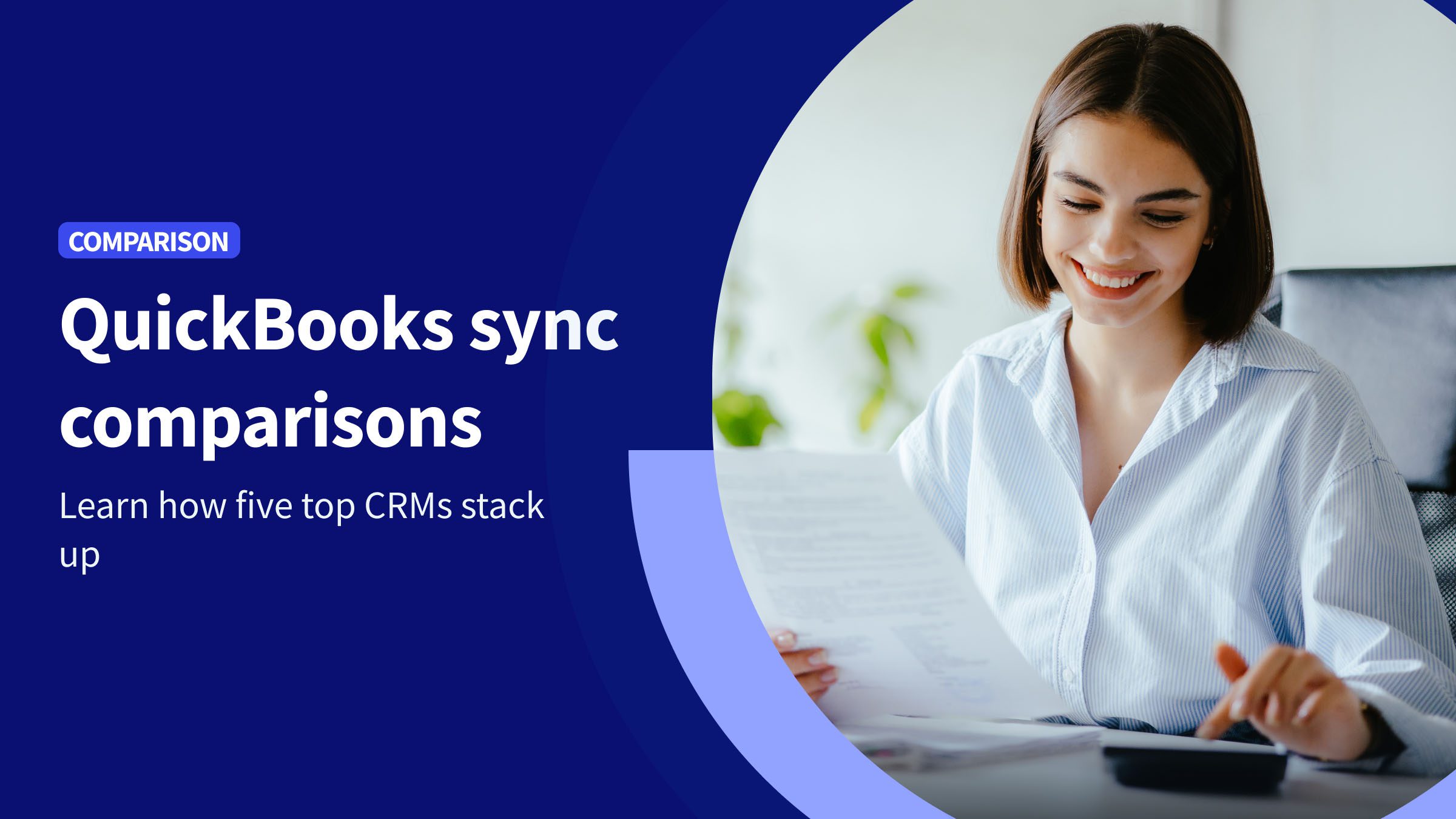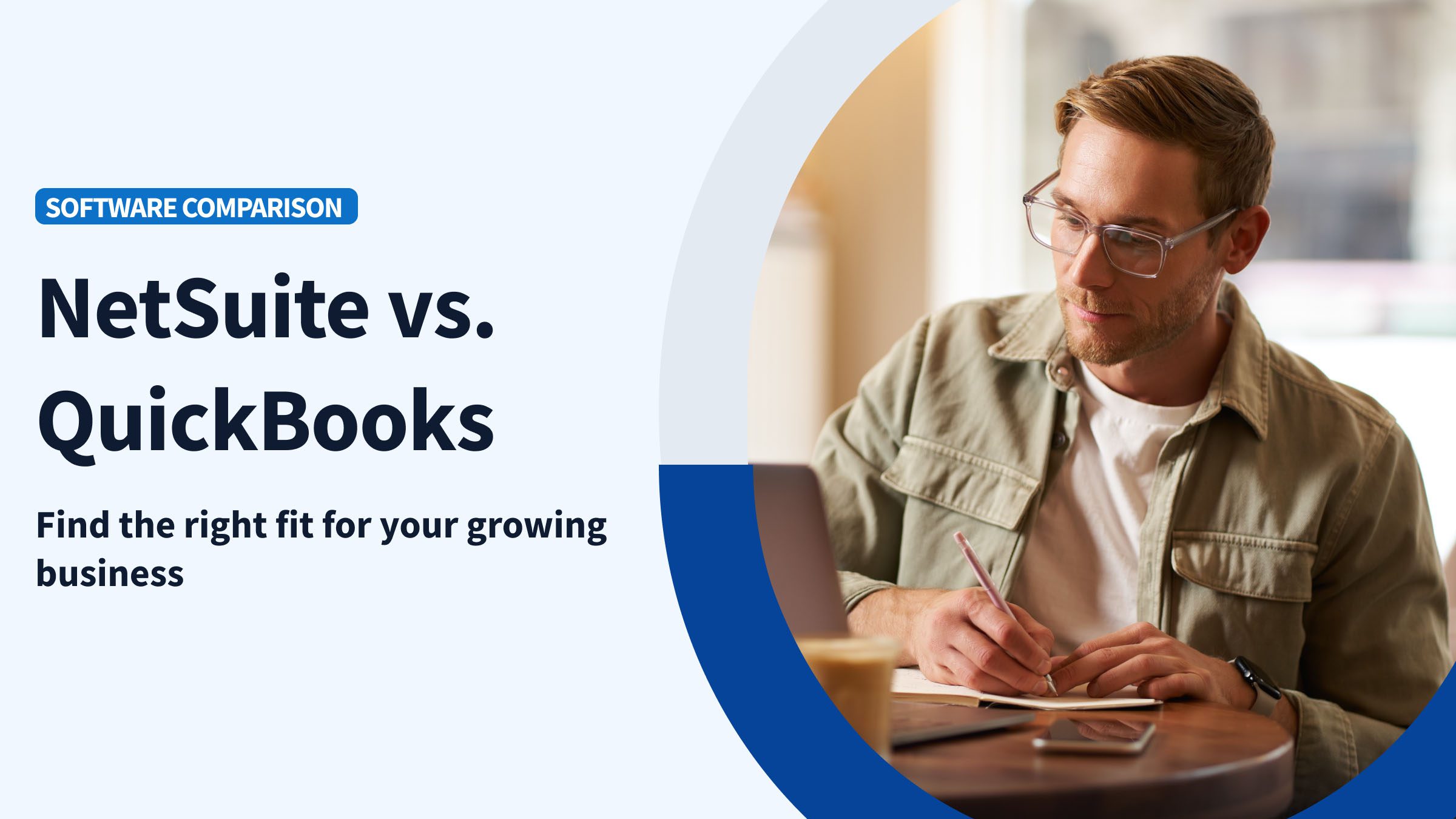Managing one business is tough. Managing several can drown even the most organized business owners in log-ins, duplicate data, and spreadsheets that never balance. If you rely on QuickBooks accounting software you’ve probably asked: “Should I use the cloud-based QuickBooks Online or stay on the Desktop version to run all my companies?”
Maybe the monthly subscription fees for several QuickBooks Online companies are adding up. Maybe toggling between company files in QuickBooks Desktop Pro is slowing your team. Either way, the choice determines real-time visibility, cash-flow insight, and the complexity of everyday bookkeeping. Or maybe you’re worried about support for QuickBooks Desktop ending altogether after its stop-sell.
Below you’ll find an in-depth guide that:
- Explains the key differences in pricing, access, security, and functionality for multi-entity setups
- Dives into advanced features like inventory management, job costing, barcode scanning, and advanced reporting
- Shows how Method—the only CRM that connects multiple QuickBooks accounts in one place—adds cloud access, automation, and consolidated dashboards so you can streamline workflows and make informed decisions without buying an ERP
Tip: Method’s multi-entity CRM connects unlimited QuickBooks Online subscriptions or Desktop files, syncs your financial data in real time, and layers user-friendly CRM tools—so your teams can focus on growth instead of juggling spreadsheets.
Let’s dive in!
Key takeaways
- Cost math is stark. QuickBooks Online charges a separate monthly fee per company; the desktop software lets you create unlimited files under one licence.
- Access vs. horsepower. The online version delivers browser and mobile app convenience plus automatic backups; Desktop still wins on advanced inventory, barcode support, and QuickBooks Desktop Enterprise tools.
- Consolidation isn’t native. Neither edition rolls up several entities into one dashboard. Method’s multi-entity feature fills that gap with cloud access and automation.
- Scalability without ERP. Pairing your preferred QuickBooks flavour with Method beats over-spending on heavyweight platforms when your business needs evolve.
QuickBooks Online vs. Desktop—why multi-company owners care
Typical “Desktop vs. Online” articles assume a single legal entity. Add three or four companies—maybe a nonprofit alongside an e-commerce offshoot—and the equation changes fast:
| Aspect | QuickBooks Online | QuickBooks Desktop |
| Set-up | Separate subscriptions per entity—one Intuit ID, many bills | Unlimited company files under one licence |
| Typical pricing for 3 companies | 3 × Plus plan at US$99 ➜ US$3,564/year (QuickBooks) | Pro Plus plan at US$569/year total (Forbes) |
| Internet connection | Required (cloud-based) | Optional—works offline; remote access via hosting or VPN |
| User switching | 1-click dropdown | Close/open files (two at once in Accountant Edition) |
| Advanced features | App marketplace; time tracking; Shopify & third-party apps | Barcode scanning, job costing, advanced inventory, batch sales tax |
| Consolidation | None—manual Excel merge | None—Enterprise “Combine Reports” is basic |
| Backups & updates | Automatic by Intuit | Manual unless hosted |
Tip: Sick of duplicate data or 12 separate log-ins? Method’s real-time two-way sync unites contacts, transactions, and inventory across every file—Desktop or QuickBooks Online—and surfaces one set of numbers for the whole group.
QuickBooks Online for multiple companies—what to expect
Set-up and subscription model
Every company needs its own QuickBooks Online plan: Simple Start, Essentials, Plus, or QuickBooks Online Advanced. There’s no bundle pricing; Intuit’s accountant wholesale billing only discounts each separate sub.
Costs and scalability
| Plan | Monthly list price (2025) | Annual cost for 3 entities |
| Simple Start | US$35 | US$1,260 |
| Plus | US$99 | US$3,564 |
| Advanced | US$235 | US$8,460 |
Intuit’s April-2025 increases pushed QuickBooks Online Advanced past the US$200 mark (QuickBooks). Convenience does cost.
Access, ease of use, and switching
The browser interface is clean and the mobile app (iOS or Android) makes on-site invoicing simple. Switching from Store A to Store B is one click, but dashboards remain siloed. Each subscription holds its own bank feeds, payroll, and expense tracking.
Feature highlights and gaps for multi-entity
Strengths
- Anywhere access for remote teams and advisors
- Automatic cloud-based backups and updates—no IT chores
- Thousands of third-party apps: Shopify, Square, time tracking, and CRM integrations
Limitations
- No consolidated P&L, cash flow, or balance-sheet roll-ups
- Inter-company bills and invoices must be re-keyed in each entity
- Using Classes to fudge multi-entity books risk audit issues for corporations or nonprofit groups
How Method extends QuickBooks Online
Hook every QuickBooks Online file up to one Method account and you’ll get:
- Multi-QuickBooks file sync that lets each entity keep its own books while HQ sees a single, tidy view of customers and sales.
- A truly centralized CRM where contacts, sales activities, employees, and customer history all live in one shared system—even if every location runs a separate QuickBooks file.
- Role-based views and controls so local teams only see what matters to them, while head office keeps the full panorama.
- Workflows tailored by location or business unit that respect local quirks without breaking overall consistency.
- Dashboards and reports you can slice any way you want, whether you’re rolling everything up for the exec team or drilling into one location’s numbers.
QuickBooks Desktop for multiple companies—what to expect
Set-up and file management
File ▸ New Company ➜ as many entities as you need. Perfect for a holding company structure with property LLCs, or a small business owner running a consultancy plus an online merch shop.
Costs & hosting
- Desktop Pro Plus: ~US$569/year (1 user) (Forbes)
- Add seats or step up to QuickBooks Desktop Enterprise: up to 40 users, advanced inventory, lot/serial tracking, barcode picking, and advanced reporting (QuickBooks)
- Third-party hosting averages US$60/month and delivers true cloud access
Advanced functionality
Desktop shines in industry-specific editions (Contractor, Manufacturing & Wholesale, Retail, Nonprofit):
- Field-level job costing and progress invoicing
- Batch sales tax adjustments and cash flow forecasts
- Advanced inventory with multiple warehouses and FIFO costing
- Custom price rules and purchase order workflows
Remote access, backups, security
Without hosting, Desktop lives on one PC (Windows; Mac users need Parallels). You manage backups, user rights, and updates—a plus for tight IT policies but a minus if you dislike server chores.
How Method extends Desktop
- Method’s browser portal lets staff create estimates, orders, or collect credit card payments anywhere; it syncs to the right company file when online.
- Centralised CRM: one customer history shows orders from every entity.
- Cloud dashboards knit together revenue, expense tracking, and KPIs across files.
- Custom workflows auto-email contractors, push Shopify orders, or schedule service visits—all while QuickBooks remains the single ledger.
Common challenges and Method’s fixes
| Challenge | QuickBooks alone | Paired with Method |
| Duplicate data entry | Update every file manually | One master record syncs in real time |
| Consolidated reporting | Manual Excel merge | Single source of truth for all of your entities |
| Inter-company entries | Re-key bills & invoices | One entry can post to both ledgers—depending on how you set it up |
| Remote team access (Desktop) | VPN or costly hosting | Browser & mobile app; desktop syncs later |
| Custom fields & workflows | Limited, rigid screens | No-code designer with unlimited custom fields |
| Audit trail & backups | Varies by edition | Cloud history + Intuit or host backups remain intact |
| Scalability | New subs or bigger licences | Method layer stays constant as companies grow |
Which mix fits your business needs?
| Priority | Base edition | Why it fits | Method bonus |
| Lowest software spend | Desktop | Unlimited files, one annual licence | Adds cloud dashboards & automation |
| Zero IT overhead | Online | Fully cloud-based, automatic updates | Unifies data across subs; extends workflows |
| Deep inventory & barcode | Desktop Enterprise | Multiple warehouses, lot tracking | Web portal for pick/pack and sales reps |
| Distributed sales force | QuickBooks Online Advanced | 25 users, strong third-party apps | Single CRM & integrated time tracking |
| Heavy e-commerce (Shopify) | Either | Both integrate; QuickBooks Online easier but Desktop faster via Web Connector | Method syncs Shopify to both editions, maps orders to correct company |
Tip: Some groups run a hybrid—keep manufacturing on Desktop Enterprise for barcode control, run a new SaaS venture on QuickBooks Online, and use Method to share contacts and roll-up revenue. Method is edition-agnostic, so you keep flexibility as you pivot.
Security, customer support, and backups
- Secure cloud access and layered protection. QuickBooks Online stores your books in Intuit-managed data centres with encryption, fraud monitoring, and automatic backups. If you use QuickBooks Desktop, security rests on your own server or hosting provider. Method adds a second shield: every sync is logged and nothing ever overwrites the original QuickBooks data.
- Responsive, human customer support. Standard Intuit plans include chat and phone help, while QuickBooks Online Advanced ups the ante with a dedicated success manager. Method delivers live onboarding specialists plus a robust knowledge base, so routine workflow tweaks don’t spiral into hours on hold.
- Regulatory compliance that fits nonprofits. QuickBooks Desktop offers ready-made chart-of-accounts for charities, and QuickBooks Online streamlines mobile fundraising with built-in donation tracking. Method pushes donor pledges or grant invoices to the correct file automatically, trimming manual errors when audit season rolls around.
Streamline multi-company finance without an ERP
QuickBooks—online or desktop—remains the most popular accounting software for SMBs because of its ease of use, robust customer support, and deep industry-specific editions. But neither flavour was built from the ground up to centralize several legal entities or automate cross-company tasks.
Method’s multi-entity platform closes that gap:
- Connect multiple QuickBooks files (Desktop, Online, or both).
- Consolidate sales, inventory, and KPIs in one dashboard—updated in real time.
- Automate approvals, reminders, and e-commerce imports with custom workflows.
- Scale from two companies to twenty without migrating to a pricey ERP.
Start a 14-day free trial and see how Method turns duplicate entry, disjointed reports, and late-night Excel merges into a single, streamlined workflow.
FAQs
Can I run more than one company on QuickBooks Online?
Yes, but each entity needs its own subscription—even under accountant wholesale pricing.
How many companies can QuickBooks Desktop handle?
Unlimited. Create a new company file for each business; storage and performance are your only real limits.
Is Desktop cheaper than Online for three companies?
On current pricing, yes. Desktop Pro Plus at US$569/year is cheaper than three QuickBooks Online Plus subs at US$3,564/year. Hosting can narrow the gap but still trends lower.
Does QuickBooks back up my data automatically?
QuickBooks Online handles backups automatically. Desktop requires manual or hosted backups—Method’s cloud sync keeps transactional history even if a local file is lost.
Do I need an ERP for consolidation and automation?
Not necessarily. QuickBooks + Method gives you consolidated dashboards, custom workflows, and real-time sync without ERP costs or complexity.






